Identification and characterization of GLDC as host susceptibility gene to severe influenza
- PMID: 30498026
- PMCID: PMC6328914
- DOI: 10.15252/emmm.201809528
Identification and characterization of GLDC as host susceptibility gene to severe influenza
Erratum in
-
Author Correction: Identification and characterization of GLDC as host susceptibility gene to severe influenza.EMBO Mol Med. 2025 Aug;17(8):2163-2164. doi: 10.1038/s44321-024-00164-5. EMBO Mol Med. 2025. PMID: 40634750 Free PMC article.
Abstract
Glycine decarboxylase (GLDC) was prioritized as a candidate susceptibility gene to severe influenza in humans. The higher expression of GLDC derived from genetic variations may confer a higher risk to H7N9 and severe H1N1 infection. We sought to characterize GLDC as functional susceptibility gene that GLDC may intrinsically regulate antiviral response, thereby impacting viral replication and disease outcome. We demonstrated that GLDC inhibitor AOAA and siRNA depletion boosted IFNβ- and IFN-stimulated genes (ISGs) in combination with PolyI:C stimulation. GLDC inhibition and depletion significantly amplified antiviral response of type I IFNs and ISGs upon viral infection and suppressed the replication of H1N1 and H7N9 viruses. Consistently, GLDC overexpression significantly promoted viral replication due to the attenuated antiviral responses. Moreover, GLDC inhibition in H1N1-infected BALB/c mice recapitulated the amplified antiviral response and suppressed viral growth. AOAA provided potent protection to the infected mice from lethal infection, comparable to a standard antiviral against influenza viruses. Collectively, GLDC regulates cellular antiviral response and orchestrates viral growth. GLDC is a functional susceptibility gene to severe influenza in humans.
Keywords: GLDC; antiviral response; genetic susceptibility; severe influenza; viral replication.
© 2018 The Authors. Published under the terms of the CC BY 4.0 license.
Conflict of interest statement
The authors declare that they have no conflict of interest.
Figures

- A, B
The genotype‐expression correlation of rs1755609 and GLDC in lymphoblast cell lines (LCLs, A) and human lung tissues (B). The box denotes the interquartile range; thick line within the box is the median; diamond represents the mean; whiskers are minimum and maximum and open dot is outlier. The genotype‐expression correlation pattern in LCLs from 77 Chinese and 72 Japanese are plotted in the left and right, respectively. The lung eQTL data from three centers are presented. Linear regression is used for data analysis.
- C
The high linkage disequilibrium (LD) pattern in three SNPs, including two association SNPs rs2438409 and rs1755609 (boxed), in multiple populations. The LD pattern is plotted using genotyping data of 77 Chinese Han in Beijing (CHB), 72 Japanese (JPT), and 73 Caucasian of European ancestry living in Utah USA (CEU) from 1000 Genomes Project. The boxes are colored according to r 2 measure on a white and gray scale. The numbers inside the boxes are r 2 measure. The gray box without number indicates the highest r 2 of 1.0.
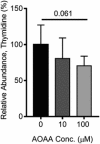

- A
A549 cells co‐transfected with pIFNβ‐Luc and TK‐Nano‐Luc were further transfected with Poly I:C (0 and 50 μg/ml) and simultaneously treated with AOAA (0 and 50 μM). The cells were lysed for luciferase assay after 16 h. A549‐Dual and A549‐Dual KO‐RIG‐I cells carrying ISRE reporter gene were transfected and treated with the indicated concentrations of Poly I:C and AOAA respectively in triplicate. After 16 h, the cell‐free supernatants were used for luciferase assay. The data present the normalized luciferase activity relative to mock Poly I:C transfection and mock AOAA treatment. Data shown are representative of three independent experiments, n = 3.
- B
A549 cells transfected with GLDC siRNA (siGLDC) or scrambled siRNA (siCtrl) were further transfected with Poly I:C (50 μg/ml). After 24 h, the cell lysates and media were harvested for detection of mRNA expression of GLDC and IFNα by RT–qPCR, and measurement of IFNα production by ELISA, respectively. Data shown are representative of three independent experiments, n = 3.

- A, B
A549 cells were inoculated with H1N1 (A) and H7N9 (B) viruses at an MOI of 0.01. The cells were treated with AOAA (0, 10, 50 μM) in triplicate prior to and after the inoculation. At the indicated hours post‐inoculation, cell lysates and cell‐free media (supernatant) were harvested for the detection of viral load with RT–qPCR assay, and viral titration with plaque assay, respectively. Data shown are representative of at least three independent experiments, n = 3. Graphs show mean ± SD. Unpaired t‐test is used for data analysis.
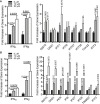
- A, B
A549 cells were inoculated with H1N1 (A) and H7N9 (B) viruses. The cells were treated with AOAA (0, 10, 50 μM) prior to and after the inoculation. At the indicated hours post‐inoculation, cell lysates were harvested for the detection of expression level of antiviral molecules with RT–qPCR assay. Data shown are representative of at least three independent experiments, n = 3. Graphs show mean ± SD. Unpaired t‐test is used for data analysis.

- A
A549 cells treated with AOAA (0, 10, 50 μM) were then inoculated H7N9 virus before and after a MOI of 0.01 inoculation. At 48 hpi, the cells were harvested for detecting expression levels of ISGs. Data shown are representative of three experiments, n = 3. Graphs show mean ± SD. Unpaired t‐test is used for data analysis.
- B
The effect of AOAA on cell viability was assessed in A549 cells. A549 cells were incubated with the indicated concentration of AOAA at 37°C for 48 h. The cell‐free culture medium was applied to MTT assay. Data shown are representative of two experiments, n = 3. Graphs show mean ± SD. Unpaired t‐test is used for data analysis.
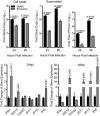
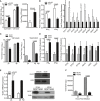
- A–D
A549 cells were transfected with GLDC siRNA (siGLDC) or scrambled siRNA (siCtrl) (A and B), or transfected with pcDNA3.1‐GLDC or pcDNA3.1‐His A vector (C and D). The transfected cells were inoculated with H7N9 virus at an MOI of 0.01. At 48 hpi, cell lysates and culture media (supernatant) of the siRNA‐transfected cells were harvested for detection of viral loads and viral titers (A). The cell lysates were collected at 24 hpi to measure the expression levels of antiviral genes (B). At the indicated hpi, cell lysates and supernatants of the plasmid‐transfected cells were harvested for viral load detection (C). The cell lysates collected at 24 hpi were used to measure the expression levels of antiviral genes (D). Data shown are representative of three experiments, n = 3. Graphs show mean ± SD. Unpaired t‐test is used for data analysis.
- E
The effective depletion of GLDC by siRNA was shown by RT–qPCR assay (left panel) and Western blot (48 hpi, upper right panel). GLDC overexpression at the indicated hpi was verified by Western blot (lower right panel). Data shown in left panel are representative of at least three experiments, n = 3. Graphs show mean ± SD. Unpaired t‐test is used for data analysis.
- F
A549 cells transfected with GLDC plasmid or vector were inoculated with MERS‐CoV in triplicate. Cell‐free culture media were harvested for detection of viral load at the indicated time points. Data shown are representative of two independent experiments, n = 3. Graphs show mean ± SD. Unpaired t‐test is used for data analysis.
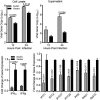

- A
Regime of the mouse experiment.
- B
Survival rates of AOAA‐, zanamivir‐, and PBS‐treated mice after infection (n = 9). Mantel–Cox test is used for data analysis.
- C
Viral loads and viral titers in the lung homogenates of the indicated mice (n = 3). Unpaired t‐test is used for data analysis. Graphs show mean ± SD.
- D
The normalized expression levels of IFNα in lung tissues of the indicated mice (n = 3) and fold change of ISGs at day 5 post‐infection. Unpaired t‐test is used for data analysis. Graphs show mean ± SD.
- E
Representative images of virus‐infected cells in the indicated mice. Mouse lung tissues are applied to immunofluorescence staining using the antibody against influenza virus NP (green) and confocal imaging.

- A, B
The body weight change of AOAA‐, zanamivir‐, and PBS‐treated mice (n = 9) after virus inoculation.
- C
Body weight change of the mice intranasally administered with AOAA (n = 3, 10 mg/kg body weight) and PBS (n = 3).
Similar articles
-
The PA-X host shutoff site 100 V exerts a contrary effect on viral fitness of the highly pathogenic H7N9 influenza A virus in mice and chickens.Virulence. 2025 Dec;16(1):2445238. doi: 10.1080/21505594.2024.2445238. Epub 2024 Dec 28. Virulence. 2025. PMID: 39731774 Free PMC article.
-
Synergistic Antiviral Activity of Xanthan Gum and Camostat Against Influenza Virus Infection.Viruses. 2025 Feb 21;17(3):301. doi: 10.3390/v17030301. Viruses. 2025. PMID: 40143232 Free PMC article.
-
Cyclosporin A alleviates influenza A (H1N1) virus-induced chronic pulmonary inflammation through decreasing IFN-γ-producing T lymphocytes.Virol J. 2025 Jul 25;22(1):255. doi: 10.1186/s12985-025-02887-4. Virol J. 2025. PMID: 40713716 Free PMC article.
-
Physical interventions to interrupt or reduce the spread of respiratory viruses.Cochrane Database Syst Rev. 2023 Jan 30;1(1):CD006207. doi: 10.1002/14651858.CD006207.pub6. Cochrane Database Syst Rev. 2023. PMID: 36715243 Free PMC article.
-
Systematic review of influenza resistance to the neuraminidase inhibitors.BMC Infect Dis. 2011 May 19;11:134. doi: 10.1186/1471-2334-11-134. BMC Infect Dis. 2011. PMID: 21592407 Free PMC article.
Cited by
-
Human Intestinal Organoids Recapitulate Enteric Infections of Enterovirus and Coronavirus.Stem Cell Reports. 2021 Mar 9;16(3):493-504. doi: 10.1016/j.stemcr.2021.02.009. Epub 2021 Feb 12. Stem Cell Reports. 2021. PMID: 33626333 Free PMC article.
-
Regulatory genome variants in human susceptibility to infection.Hum Genet. 2020 Jun;139(6-7):759-768. doi: 10.1007/s00439-019-02091-9. Epub 2019 Dec 5. Hum Genet. 2020. PMID: 31807864 Free PMC article. Review.
-
Human Nasal Organoids Model SARS-CoV-2 Upper Respiratory Infection and Recapitulate the Differential Infectivity of Emerging Variants.mBio. 2022 Aug 30;13(4):e0194422. doi: 10.1128/mbio.01944-22. Epub 2022 Aug 8. mBio. 2022. PMID: 35938726 Free PMC article.
-
Seroprevalence of H7N9 infection among humans: A systematic review and meta-analysis.Influenza Other Respir Viruses. 2020 Sep;14(5):587-595. doi: 10.1111/irv.12736. Epub 2020 Mar 10. Influenza Other Respir Viruses. 2020. PMID: 32157809 Free PMC article.
-
Mycoplasma glycine cleavage system key subunit GcvH is an apoptosis inhibitor targeting host endoplasmic reticulum.PLoS Pathog. 2024 May 24;20(5):e1012266. doi: 10.1371/journal.ppat.1012266. eCollection 2024 May. PLoS Pathog. 2024. PMID: 38787906 Free PMC article.
References
-
- Albright FS, Orlando P, Pavia AT, Jackson GG, Cannon Albright LA (2008) Evidence for a heritable predisposition to death due to influenza. J Infect Dis 197: 18–24 - PubMed
Publication types
MeSH terms
Substances
LinkOut - more resources
Full Text Sources
Other Literature Sources
Medical

